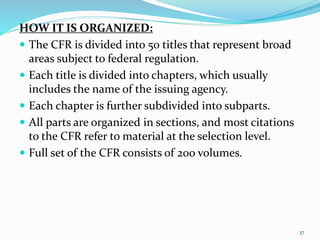This document provides a summary of a presentation on generic drugs. It discusses the definition of generic drugs, the generic drug development and approval process, provisions of the Hatch-Waxman Act, and relevant sections of the Code of Federal Regulations. The summary highlights that a generic drug must be equivalent to the branded version in ingredients, dosage, safety and efficacy. It also outlines the steps in generic drug approval via an Abbreviated New Drug Application, including requirements for bioequivalence testing and patent certifications. Additionally, it notes provisions established by the Hatch-Waxman Act related to patent term extensions and patent challenges involved in the generic approval pathway.








































